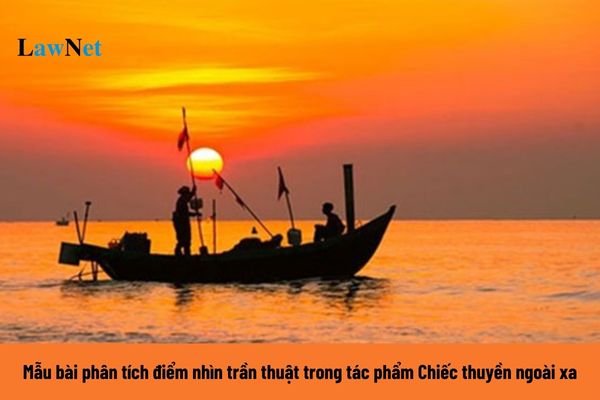Vietnam: What is the sample analysis of narrative perspective in the work "Chiếc thuyền ngoài xa"? What learning outcomes are required for argumentation content in the 12th-grade Literature curriculum?
What is the sample analysis of narrative perspective in the work "Chiếc thuyền ngoài xa"?
Below is a sample analysis of the narrative perspective in the work "Chiếc thuyền ngoài xa":
Introduction to the Author and Work
Nguyen Minh Chau (1930 - 1989) is one of the profoundly influential writers in modern Vietnamese literature. His works often reflect human life in the context of post-war Vietnamese society, depicting a transformation in perception and artistic thinking. "Chiếc thuyền ngoài xa" is one of his representative works, written in 1983, during a period when Vietnamese literature was transitioning from war issues to matters of peace and human life in the new society.
The work "Chiếc thuyền ngoài xa" is not merely a story about beauty and pain in life but is also a deeply philosophical piece, addressing the conflict between beauty and ugliness, between ideals and reality. The artistic perspective in the work is a crucial factor in helping readers access the profound meanings of the story and its characters.
Artistic Perspective in "Chiếc thuyền ngoài xa"
The perspective in the work "Chiếc thuyền ngoài xa" is primarily expressed through the character Phung — a soldier who has experienced war and is now a war correspondent. Phung is the main character of the work, and through his eyes, the story unfolds with very distinctive details.
1. Direct Perspective of the Character Phung
Phung's perspective is a key element in conveying the message of the work. Phung, when witnessing the distant boat in the perfect picture, initially holds an idealized view of beauty. When Phung sees the tranquil sea, with the boat gliding on the waves amidst the hazy light, he sees it as a perfect picture, the embodiment of absolute beauty. He feels the beauty of nature and life, devoid of pain or hardship. This description shows the perspective of a post-war soldier, full of ideals and aspirations to seek beauty in ordinary life.
2. Perspective from Phung's Disillusionment
However, Phung's perspective is not limited to idealization. His view changes the moment he witnesses the reality behind the initial beauty of the picture. The boat is not only a beautiful image but also a symbol of suffering, poverty, and violence. When the boat docks, Phung discovers that in reality, the woman he saw in the picture is being brutally beaten by her husband. From here, Phung's perspective shifts to a completely different angle, from a view of idealized beauty to a view of the harsh and unjust reality of life. Through this, author Nguyen Minh Chau emphasizes a reality that beauty does not always equate to perfection and ideals. Behind beauty can lie sorrows and pains that are not easily seen.
3. Multidimensional Perspective through the Characters Dau and the Woman
The artistic perspective in the work is expanded by the appearance of other characters, such as Dau (a judicial officer) and the abused woman. Dau, through his viewpoint, analyzes the evil in society and the cruelty in the husband's actions, yet lacks the power to change the situation. This allows readers to recognize that in society, not all issues can be easily resolved, even by those in power.
The abused woman, despite enduring humiliation, remains attached to her violent husband, expressing another view of life's complexities. Her perspective, in terms of reason, can be understood as accepting the bad to survive because she has no other choice.
Effect of Artistic Perspective in the Work
The artistic perspective in "Chiếc thuyền ngoài xa" helps create psychological depth for the characters, especially Phung. Through this, the work vividly portrays the transformation in human perception: from idealizing beauty to facing the harsh realities of life. By employing Phung's perspective, Nguyen Minh Chau enables readers to perceive the conflict between idealized beauty and real ugliness, while depicting the pain and helplessness of people when confronted with reality.
Additionally, artistic perspective aids the work in building complexity in the relationships between characters, thereby highlighting the themes of beauty, ugliness, injustice, and suffering in society. Phung's perspective, though an outsider, carries a deep empathy, helping him understand the tragedies of people in impoverished life, thereby deriving valuable lessons about multidimensional insight and awakening in life.
Conclusion
The artistic perspective in "Chiếc thuyền ngoài xa" by Nguyen Minh Chau not only helps create dramatic situations but also significantly contributes to expressing profound philosophical values about life. Consequently, the work emphasizes the necessity of understanding life not only through surface appearances but also confronting the complex issues, difficulties, and hidden tragedies in society. The multidimensional perspective of the work encourages readers to reflect on the relationship between beauty and ugliness, between ideals and reality, thereby gaining deeper insights into life and humanity.
Note: The above article is for reference only!

What is the sample analysis of narrative perspective in the work "Chiếc thuyền ngoài xa"? What learning outcomes are required for argumentation content in the 12th-grade Literature curriculum in Vietnam? (Image from the Internet)
What learning outcomes are required for argumentation content in the 12th-grade Literature curriculum in Vietnam?
According to the General Education Program in Literature issued with Circular 32/2018/TT-BGDDT:
- Content reading comprehension
+ Recognize and analyze the content of the topic, the thesis, reasonings, and unique evidence in the text; identify their connections; evaluate the appropriateness between the argumentative content and the title of the text.
+ Know how to perceive and evaluate content with critical thinking; recognize the purpose,
- Form reading comprehension
+ Analyze and evaluate the author's use of some argumentative operations (such as proving, explaining, commenting, comparing, analyzing, or refuting) in the text to achieve the purpose.
+ Analyze the rhetorical devices, vocabulary, and affirmative and negative sentences in the argumentative text, evaluating the effectiveness of using these forms.
+ Recognize and analyze the role of argumentation methods and expressive language in argumentative texts.
What are the perspectives on developing the Literature curriculum in Vietnam?
According to the General Education Program for Literature issued with Circular 32/2018/TT-BGDDT, perspectives on developing the Literature curriculum in Vietnam are as follows:
The Literature curriculum adheres to the basic regulations stated in the General Program while emphasizing several perspectives:
- The Literature curriculum is developed on theoretical and practical foundations, updates on research achievements in education, psychology, and teaching methodology of Vietnamese literature; achievements in literature and linguistics research; achievements in Vietnamese literature across various periods; experiences in developing Vietnamese literature curricula, particularly from the early 21st century until now, and international trends in curriculum development in general, and the Literature curriculum in particular over recent years, especially from developed countries; societal practice, education, economic conditions, and Vietnamese cultural tradition, especially the diversity of students in terms of regions, conditions, and learning abilities.
- The Literature curriculum focuses on training communication skills (reading, writing, speaking, and listening) as a central theme throughout all three education levels to meet the program's capacity-oriented direction and ensure coherence and continuity across all grades and levels. Fundamental, foundational knowledge about the Vietnamese language and literature is formed through activities in comprehending and creating texts; directly serving the requirement of training in reading, writing, speaking, and listening skills.
- The Literature curriculum is developed with an open approach, reflected in not specifying detailed teaching content but stipulating the outcomes needed in reading, writing, speaking, and listening for each grade; delineating some basic, core knowledge about the Vietnamese language, literature, and some texts with a significant, crucial position in national literature as mandatory content for students nationwide.
- The Literature curriculum meets both the innovation requirements and emphasizes inheriting and enhancing the strengths of existing Vietnamese literature curricula, especially the current one.

